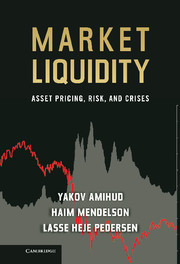Book contents
- Frontmatter
- Contents
- Acknowledgments
- Introduction and Overview of the Book
- Part I The Effect of Liquidity Costs on Securities Prices and Returns
- Chapter 1 Asset Pricing and the Bid–Ask Spread
- Chapter 2 Liquidity, Maturity, and the Yields on U.S. Treasury Securities
- Liquidity, Maturity, and the Yields on U.S. Treasury Securities*
- Chapter 3 Market Microstructure and Securities Values: Evidence from the Tel Aviv Stock Exchange
- Market Microstructure and Securities Values Evidence from the Tel Aviv Stock Exchange*
- Part II Liquidity Risk
- Part III Liquidity Crises
- References for Introductions and Summaries
- Index
- References
Market Microstructure and Securities Values Evidence from the Tel Aviv Stock Exchange*
Journal of Financial Economics 45, 1997
Published online by Cambridge University Press: 05 December 2012
- Frontmatter
- Contents
- Acknowledgments
- Introduction and Overview of the Book
- Part I The Effect of Liquidity Costs on Securities Prices and Returns
- Chapter 1 Asset Pricing and the Bid–Ask Spread
- Chapter 2 Liquidity, Maturity, and the Yields on U.S. Treasury Securities
- Liquidity, Maturity, and the Yields on U.S. Treasury Securities*
- Chapter 3 Market Microstructure and Securities Values: Evidence from the Tel Aviv Stock Exchange
- Market Microstructure and Securities Values Evidence from the Tel Aviv Stock Exchange*
- Part II Liquidity Risk
- Part III Liquidity Crises
- References for Introductions and Summaries
- Index
- References
Summary
Introduction
Securities markets around the world are making major investments to improve their trading technology. The London Stock Exchange is phasing in an automated, order-driven trading system to improve liquidity and reduce trading costs (see, London Stock Exchange, 1996). The current plan is to implement the system for the FTSE-100 stocks while preserving the traditional quote-driven system for large block trades. Other European stock exchanges (e.g., the French, Italian, Spanish, and Swedish markets) have converted their trading systems from the traditional call market to computer-based continuous trading alternatives. The stock exchanges of Toronto, Montreal, Vancouver, and Alberta have recently changed their trading systems to support decimal pricing ‘in a bid to increase liquidity’ (Reuters, 1996). In the United States, the Securities and Exchange Commission has introduced new rules requiring market-makers to incorporate in their public quotes both customer limit orders and orders they quote on electronic communication networks such as Instinet and Selectnet. These rules are intended to improve liquidity through increased market transparency and enhanced quality of execution (see, Securities and Exchange Commission, 1996). These reforms were partly triggered by the studies of Christie and Schultz (1994) and Christie et al. (1994), who presented evidence that market makers implicitly colluded to maintain high bid--ask spreads, and Huang and Stoll (1996), who showed that Nasdaq spreads exceeded NYSE benchmarks. Further, emerging markets are evaluating and implementing new trading systems, and are making considerable investments in improving their microstructure.
A question of interest for both financial economists and practitioners is whether investments in improving the market microstructure have positive value. The answer relates to the raison d’être of market microstructure research, and it can quantify the benefits of improving trading mechanisms. This paper examines the value of an improvement in the market microstructure for selected stocks on the Tel Aviv Stock Exchange (TASE).
- Type
- Chapter
- Information
- Market LiquidityAsset Pricing, Risk, and Crises, pp. 72 - 100Publisher: Cambridge University PressPrint publication year: 2012
References
- 3
- Cited by



